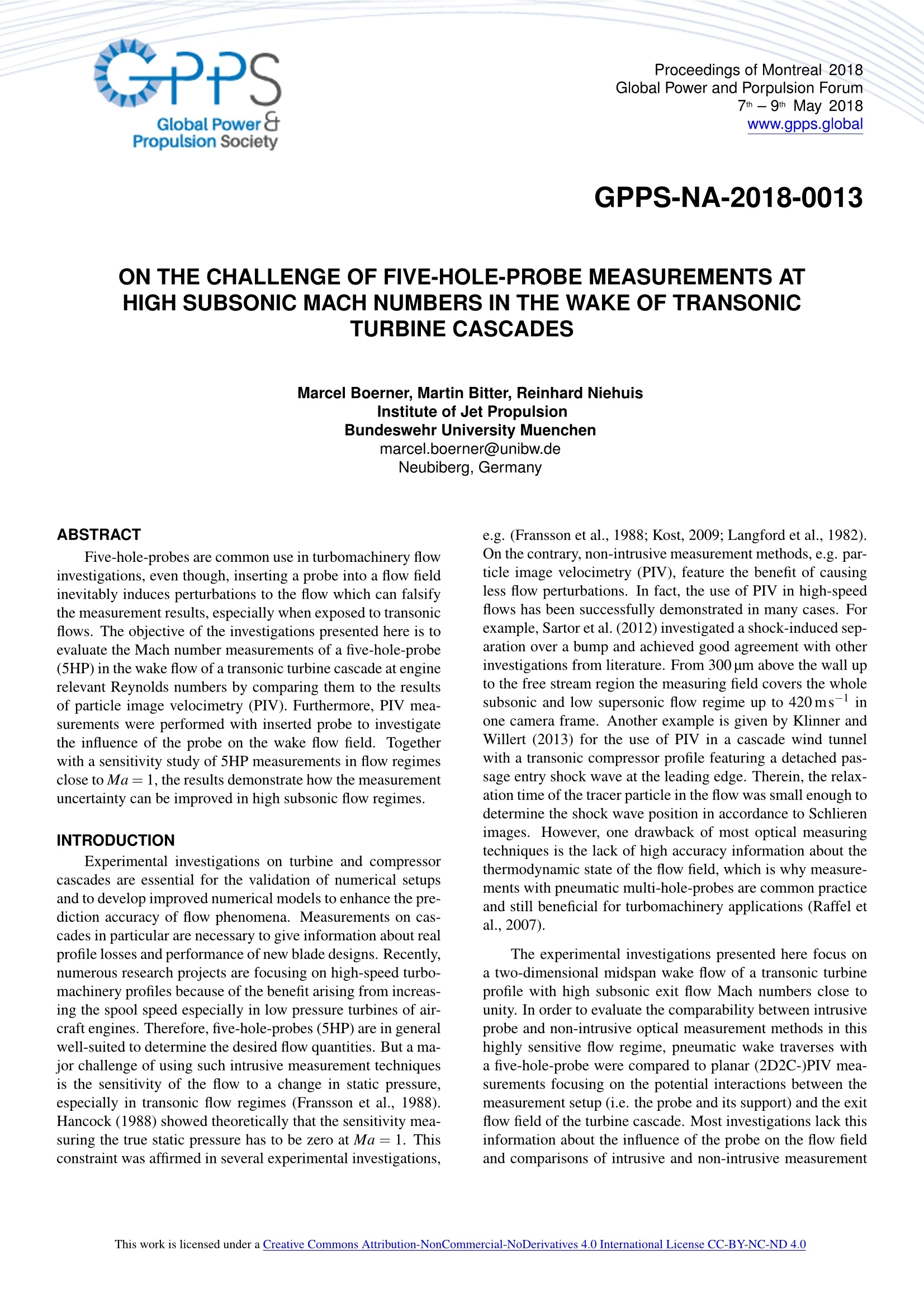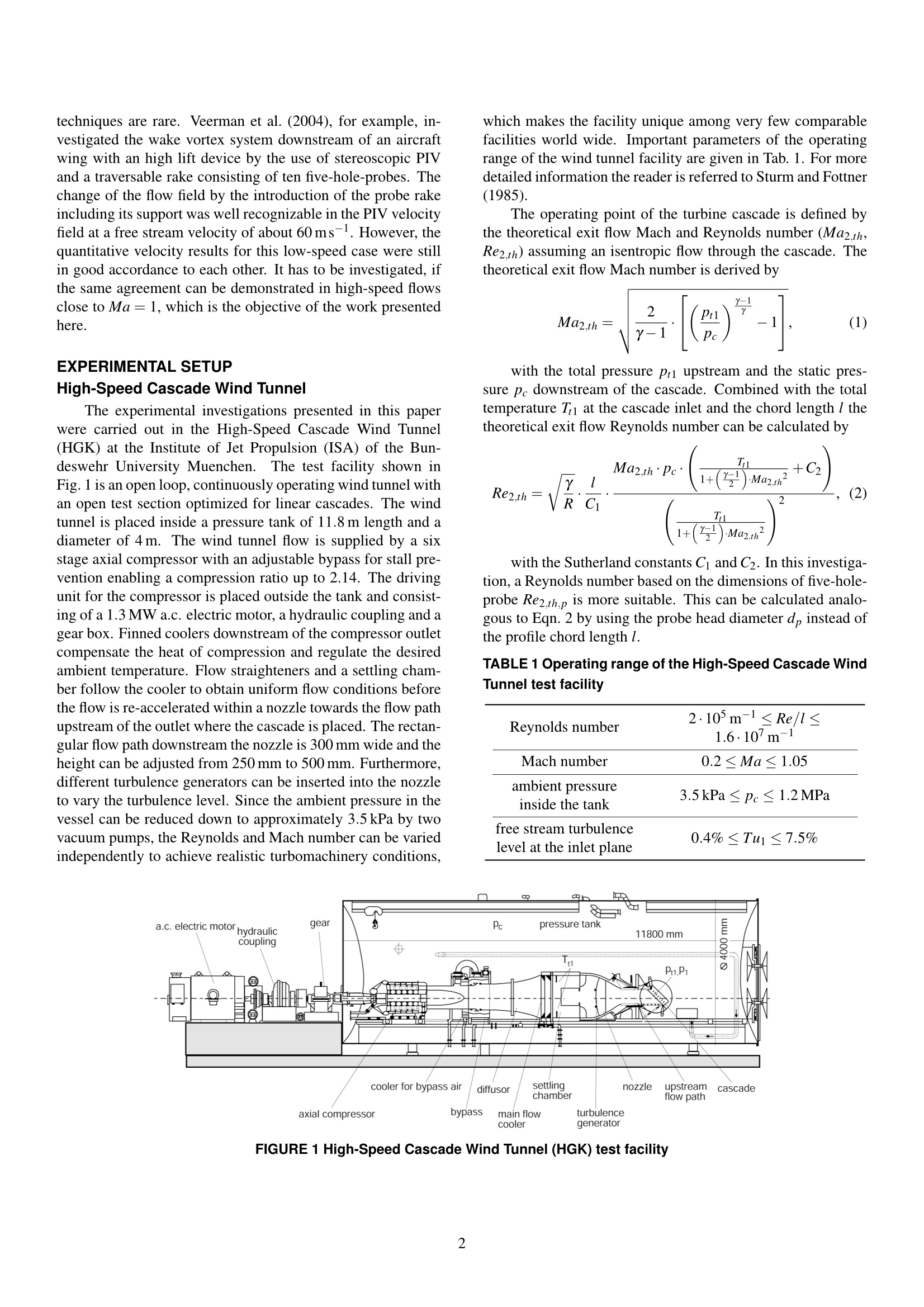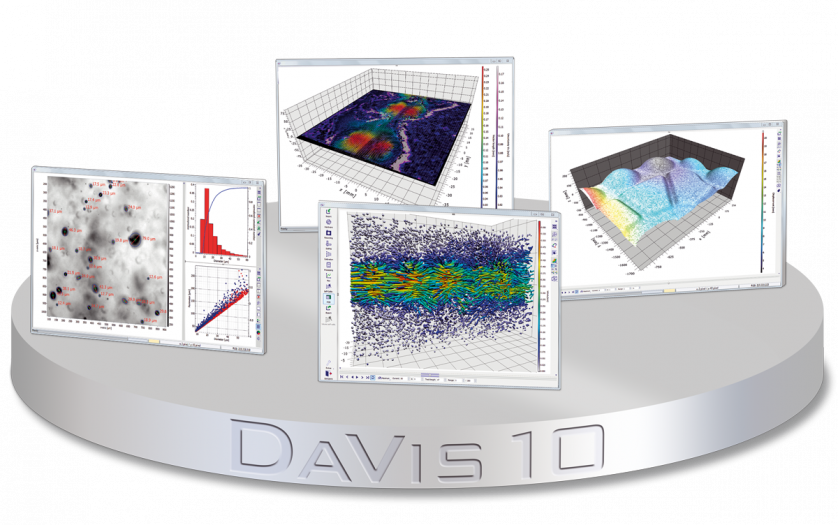方案详情文
智能文字提取功能测试中
Proceedings of Montreal 2018 Global Power and Porpulsion Forum7th -9th May 2018 www.gpps.global GPPS-NA-2018-0013 ON THE CHALLENGE OF FIVE-HOLE-PROBE MEASUREMENTS ATHIGH SUBSONIC MACH NUMBERS IN THE WAKE OF TRANSONICTURBINE CASCADES Marcel Boerner, Martin Bitter, Reinhard Niehuis Institute of Jet Propulsion Bundeswehr University Muenchen marcel.boerner@unibw.de Neubiberg, Germany Five-hole-probes are common use in turbomachinery flowinvestigations, even though, inserting a probe into a flow fieldinevitably induces perturbations to the flow which can falsifythe measurement results, especially when exposed to transonicflows. The objective of the investigations presented here is toevaluate the Mach number measurements of a five-hole-probe(5HP) in the wake flow of a transonic turbine cascade at enginerelevant Reynolds numbers by comparing them to the resultsof particle image velocimetry (PIV). Furthermore, PIV mea-surements were performed with inserted probe to investigatethe influence of the probe on the wake flow field. Togetherwith a sensitivity study of 5HP measurements in flow regimesclose to Ma=1, the results demonstrate how the measurementuncertainty can be improved in high subsonic flow regimes. INTRODUCTION Experimental investigations on turbine and compressorcascades are essential for the validation of numerical setupsand to develop improved numerical models to enhance the pre-diction accuracy of flow phenomena. Measurements on cas-cades in particular are necessary to give information about realprofile losses and performance of new blade designs. Recently,numerous research projects are focusing on high-speed turbo-machinery profiles because of the benefit arising from increas-ing the spool speed especially in low pressure turbines of air-craft engines. Therefore, five-hole-probes (5HP) are in generalwell-suited to determine the desired flow quantities. But a ma-jor challenge of using such intrusive measurement techniquesis the sensitivity of the flow to a change in static pressure,especially in transonic flow regimes (Fransson et al., 1988).Hancock (1988) showed theoretically that the sensitivity mea-suring the true static pressure has to be zero at Ma=1. Thisconstraint was affirmed in several experimental investigations, e.g. (Fransson et al., 1988; Kost, 2009; Langford et al., 1982).On the contrary, non-intrusive measurement methods, e.g. par-ticle image velocimetry (PIV), feature the benefit of causingless flow perturbations. In fact, the use of PIV in high-speedflows has been successfully demonstrated in many cases. Forexample, Sartor et al. (2012) investigated a shock-induced sep-aration over a bump and achieved good agreement with otherinvestigations from literature. From 300 um above the wall upto the free stream region the measuring field covers the wholesubsonic and low supersonic flow regime up to 420ms- inone camera frame. Another example is given by Klinner andWillert (2013) for the use of PIV in a cascade wind tunnelwith a transonic compressor profile featuring a detached pas-sage entry shock wave at the leading edge. Therein, the relax-ation time of the tracer particle in the flow was small enough todetermine the shock wave position in accordance to Schlierenimages. However, one drawback of most optical measuringtechniques is the lack of high accuracy information about thethermodynamic state of the flow field, which is why measure-ments with pneumatic multi-hole-probes are common practiceand still beneficial for turbomachinery applications (Raffel etal.,2007). The experimental investigations presented here focus ona two-dimensional midspan wake flow of a transonic turbineprofile with high subsonic exit flow Mach numbers close tounity. In order to evaluate the comparability between intrusiveprobe and non-intrusive optical measurement methods in thishighly sensitive flow regime, pneumatic wake traverses witha five-hole-probe were compared to planar (2D2C-)PIV mea-surements focusing on the potential interactions between themeasurement setup (i.e. the probe and its support) and the exitflow field of the turbine cascade. Most investigations lack thisinformation about the influence of the probe on the flow fieldand comparisons of intrusive and non-intrusive measurement techniques are rare. Veerman et al. (2004), for example, in-vestigated the wake vortex system downstream of an aircraftwing with an high lift device by the use of stereoscopic PIVand a traversable rake consisting of ten five-hole-probes. Thechange of the flow field by the introduction of the probe rakeincluding its support was well recognizable in the PIV velocityfield at a free stream velocity of about 60 ms-1. However, thequantitative velocity results for this low-speed case were stillin good accordance to each other. It has to be investigated, ifthe same agreement can be demonstrated in high-speed flowsclose to Ma =1, which is the objective of the work presentedhere. EXPERIMENTAL SETUPHigh-Speed Cascade Wind Tunnel The experimental investigations presented in this paperwere carried out in the High-Speed Cascade Wind Tunnel(HGK) at the Institute of Jet Propulsion (ISA) of the Bun-deswehr University Muenchen. The test facility shown inFig. 1 is an open loop, continuously operating wind tunnel withan open test section optimized for linear cascades. The windtunnel is placed inside a pressure tank of 11.8 m length and adiameter of 4m. The wind tunnel flow is supplied by a sixstage axial compressor with an adjustable bypass for stall pre-vention enabling a compression ratio up to 2.14. The drivingunit for the compressor is placed outside the tank and consist-ing of a 1.3 MW a.c. electric motor, a hydraulic coupling and agear box. Finned coolers downstream of the compressor outletcompensate the heat of compression and regulate the desiredambient temperature. Flow straighteners and a settling cham-ber follow the cooler to obtain uniform flow conditions beforethe flow is re-accelerated within a nozzle towards the flow pathupstream of the outlet where the cascade is placed. The rectan-gular flow path downstream the nozzle is 300 mm wide and theheight can be adjusted from 250 mm to 500 mm. Furthermore,different turbulence generators can be inserted into the nozzleto vary the turbulence level. Since the ambient pressure in thevessel can be reduced down to approximately 3.5 kPa by twovacuum pumps, the Reynolds and Mach number can be variedindependently to achieve realistic turbomachinery conditions, which makes the facility unique among very few comparablefacilities world wide. Important parameters of the operatingrange of the wind tunnel facility are given in Tab. 1. For moredetailed information the reader is referred to Sturm and Fottner(1985). The operating point of the turbine cascade is defined bythe theoretical exit flow Mach and Reynolds number (Ma2,th,Re2,th) assuming an isentropic flow through the cascade. Thetheoretical exit flow Mach number is derived by with the total pressure pti upstream and the static pres-sure pe downstream of the cascade. Combined with the totaltemperature T at the cascade inlet and the chord length I thetheoretical exit flow Reynolds number can be calculated by with the Sutherland constants C and C2. In this investiga-tion, a Reynolds number based on the dimensions of five-hole-probe Re2,th,p is more suitable. This can be calculated analo-gous to Eqn. 2 by using the probe head diameter dp instead ofthe profile chord length l. TABLE 1 Operating range of the High-Speed Cascade WindTunnel test facility Reynolds number 2·10 m-1≤Re/l≤ 1.6·10'm-1 Mach number 0.2
-
1/9

-
2/9

还剩7页未读,是否继续阅读?
继续免费阅读全文产品配置单
北京欧兰科技发展有限公司为您提供《跨音速涡轮叶栅尾流中速度场PIV检测方案(CCD相机)》,该方案主要用于航天中速度场PIV检测,参考标准《暂无》,《跨音速涡轮叶栅尾流中速度场PIV检测方案(CCD相机)》用到的仪器有德国LaVision PIV/PLIF粒子成像测速场仪、LaVision DaVis 智能成像软件平台。
我要纠错
推荐专场
相关方案









 咨询
咨询